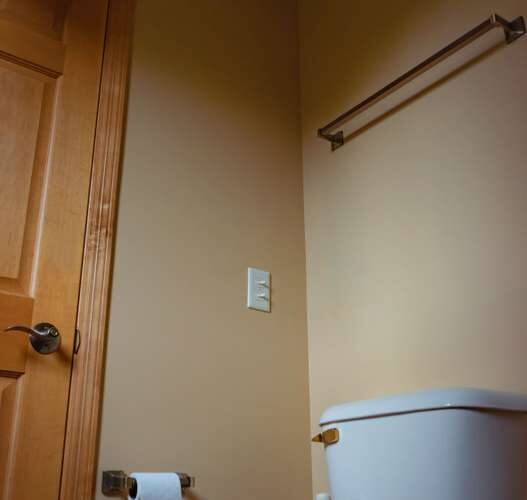
Small Bathrooms: Repurposing Unused Space: Converting Closets and Nooks
Repurposing Unused Space: Converting Closets and Nooks into Small Bathrooms
Unlocking Hidden Potential in Small Homes:
In homes with limited square footage or those with older designs, there often exists a world of hidden potential waiting to be unleashed. These homes may feature more compartmentalized layouts, where nooks, closets, and corners are frequently overlooked or dismissed as unusable. These are the spaces that hold the promise of transformation, making them particularly appealing in smaller or older houses.
While the potential for repurposing small spaces exists in various types of homes, it ultimately depends on the homeowner’s creativity and vision to recognize and unlock this potential. These often-ignored spaces can become valuable assets, enhancing both the functionality of your home and its overall worth.
Repurposing Small Spaces: From Nooks to Small Bathrooms:
The concept of repurposing is akin to discovering hidden treasure in your own backyard. It’s the ingenious art of taking neglected or overlooked spaces and converting them into functional, purpose-driven areas. In the realm of home improvement, one of the most exciting and rewarding repurposing projects involves transforming closets and nooks into fully functional small bathrooms. This imaginative approach not only maximizes the use of available space but also brings an elevated level of convenience and comfort to your daily life.
Small Bathroom Repurposing: Design, Plan, and Save:
In this article, we will embark on a journey through the realm of repurposing unused space in your home, focusing on the creative conversion of closets and nooks into small bathrooms. We will delve deep into the design principles, planning considerations, and cost-effective solutions that make these transformations possible.
Our aim is to provide you with the inspiration and practical guidance needed to recognize the hidden potential within your home, so you can embark on your own journey of repurposing with confidence and creativity. Whether you seek to add value to your property or simply enhance your daily living experience, the power of repurposing small spaces is at your fingertips.
Assessing Unused Space
In the quest to maximize your home’s potential, the first step is to identify the untapped spaces that often go unnoticed. These hidden corners may include closets, nooks, and even the space beneath a staircase. Converting these often-dismissed areas into functional small bathrooms brings forth several advantages.
It not only optimizes space utilization but also enhances property value and adds convenience to your daily life. However, the journey of transformation begins with careful consideration of the available space and its proximity to plumbing and electrical connections. Let’s explore these considerations and innovative solutions to unlock the hidden potential within your home.
- Identify Unused Spaces: Examine areas like closets, nooks, and under-stair spaces.
- Example: Underutilized hallway closet or the area beneath a staircase.
- Advantages of Conversion:
- Maximize space utilization.
- Enhance property value.
- Add convenience.
- Unleash hidden potential.
- Space Considerations:
- Evaluate space availability for a functional bathroom.
- Assess proximity to plumbing and electrical connections.
- Ensure feasibility and practicality.
- Seek creative solutions for space constraints.
Design and Layout
Designing small bathrooms is a creative blend of functionality and aesthetics. In this section, we explore the art of optimizing limited space to create stylish and efficient small bathrooms that cater to both your practical needs and your sense of style. It’s a journey where every detail, from layout options to fixtures and storage solutions, plays a pivotal role in transforming your compact space into a charming and functional retreat.
- Design Strategies for Maximizing Small Bathrooms:
- Efficient space utilization.
- Creative design concepts.
- Compact fixtures and layouts.
- Visual tricks to enhance perceived space.
- Example: Use wall-mounted vanities to free up floor space.
- Layout Options and Fixtures:
- Consider compact fixtures, such as corner showers or wall-mounted toilets.
- Explore layout choices to optimize traffic flow.
- Incorporate space-saving storage solutions.
- Example: Utilize pocket doors for space-efficient entrances.
- Functionality and Aesthetics:
- Prioritize functional elements like storage and usability.
- Blend functionality with aesthetics for a stylish result.
- Incorporate light and airy design for a spacious feel.
- Example: Use light-colored tiles and fixtures to create a visually open atmosphere.
Plumbing and Electrical Considerations
In the process of repurposing spaces into small bathrooms, plumbing and electrical considerations take center stage. Ensuring that these essential systems are seamlessly integrated into your new bathroom is crucial for functionality and safety. This section explores the intricate world of plumbing and electrical requirements, addressing potential challenges and providing practical solutions to ensure a smooth transformation.
- Addressing Plumbing and Electrical Requirements:
- Plan for plumbing and electrical connections.
- Ensure compatibility with the existing systems.
- Seek professional assistance if needed.
- Example: Running new water supply lines and drain pipes for fixtures.
- Challenges and Solutions:
- Anticipate potential issues, such as rewiring or drainage modifications.
- Find innovative solutions to overcome challenges.
- Example: Installing an upflush toilet to handle drainage issues.
- Code Compliance and Safety:
- Prioritize code compliance for plumbing and electrical work.
- Ensure safety through proper installation and inspections.
- Example: Meeting local building codes for bathroom installations.
Cost-Efficient Approaches
Transforming unused spaces into small bathrooms doesn’t have to break the bank. In this section, we’ll delve into cost-effective strategies that help you achieve your bathroom renovation goals while staying within budget. From creative ideas for repurposing to choosing wallet-friendly fixtures and materials, we’ll cover everything you need to know to make the most of your resources.
- Cost-Effective Ideas for Conversions:
- Explore innovative, budget-conscious approaches.
- Optimize the use of existing structures.
- Repurpose materials for sustainability.
- Example: Using reclaimed wood for bathroom vanities.
- Budget-Friendly Fixtures and Materials:
- Discuss affordable fixture and material choices.
- Balance cost and quality for the best value.
- Highlight options that don’t compromise style.
- Example: Selecting laminate flooring for a stylish yet economical option.
- DIY vs. Professional Assistance:
- Weigh the pros and cons of DIY projects.
- Consider when professional help is cost-effective.
- Discuss ways to save through DIY while maintaining quality.
- Example: Tackling painting and cosmetic upgrades as DIY projects.
Creative Storage Solutions
Effective storage is a cornerstone of small bathroom design, ensuring a clutter-free and organized space. In this section, we’ll underscore the significance of storage in small bathrooms and explore innovative ideas tailored to repurposed spaces. You’ll discover tips and tricks for optimizing storage without compromising the limited space you have.
- Importance of Storage in Small Bathrooms:
- Highlight the value of storage for organization and functionality.
- Discuss the impact on daily convenience and aesthetics.
- Showcase creative storage solutions as style elements.
- Example: Wall-mounted shelves as functional decor pieces.
- Innovative Storage Ideas:
- Share specific storage concepts that suit converted spaces.
- Utilize underutilized areas for built-in storage.
- Embrace over-the-toilet and recessed storage options.
- Example: Custom-built niche storage within shower enclosures.
- Optimizing Storage Space:
- Offer tips for maximizing storage without sacrificing space.
- Address how to declutter and organize effectively.
- Ensure accessible and user-friendly storage solutions.
- Example: Use baskets and containers for organized vanity storage.
Lighting and Ventilation
Lighting and ventilation play a pivotal role in any bathroom, and that significance is amplified when converting spaces into small bathrooms. This section delves into the crucial aspects of creating a well-illuminated and well-ventilated environment, where comfort and functionality coexist seamlessly.
- The Role of Lighting and Ventilation:
- Highlight the significance of proper lighting and ventilation.
- Emphasize their impact on space perception and comfort.
- Discuss their role in preventing moisture-related issues.
- Example: Avoiding mold and mildew growth through ventilation.
- Fixture Choices and Natural Light Solutions:
- Explore fixture options, such as task lighting and ambient illumination.
- Consider natural light solutions for a more open feel.
- Optimize fixture placement for maximum functionality.
- Example: Installing a skylight for natural light and ventilation.
- A Comfortable and Well-Lit Environment:
- Ensure a bathroom environment that is both comfortable and well-lit.
- Address the importance of balanced lighting.
- Highlight the connection between lighting, ventilation, and aesthetics.
- Example: Using dimmer switches for adjustable lighting.
Permitting and Regulations
Converting spaces into functional bathrooms involves navigating the intricate world of permits and regulations. In this section, we’ll delve into the legal and regulatory aspects of these transformations, ensuring your project complies with all the necessary requirements. You’ll find guidance on obtaining permits, meeting building codes, and overcoming potential hurdles along the way.
- Legal and Regulatory Aspects:
- Address the legal framework surrounding bathroom conversions.
- Discuss the relevance of local building codes.
- Emphasize the importance of compliance for safety and quality.
- Example: The need for electrical and plumbing permits.
- Obtaining Necessary Permits:
- Provide guidance on the permit application process.
- Discuss the specific permits required for bathroom conversions.
- Emphasize the benefits of following the correct procedures.
- Example: Acquiring building permits for structural changes.
- Navigating Potential Hurdles:
- Explain common challenges and how to navigate them.
- Highlight the importance of professional assistance when needed.
- Offer tips for a smoother permitting and regulatory process.
- Example: Working with an architect to meet complex building codes.
Case Studies and Inspirations
There’s nothing quite as inspiring as real-life success stories. In this section, we present case studies of successful space conversions, showcasing the transformative power of repurposing nooks, closets, and underutilized areas into charming small bathrooms. Prepare to be inspired by unique design solutions, creative approaches, and captivating before-and-after transformations.
- Showcasing Real-Life Success:
- Present compelling case studies that demonstrate the possibilities.
- Share the journeys of homeowners who successfully converted spaces.
- Highlight the value of practical and stylish small bathrooms.
- Example: A closet-turned-bathroom with efficient storage solutions.
- Unique and Creative Design Solutions:
- Explore innovative design ideas from various projects.
- Emphasize creative and aesthetically pleasing solutions.
- Encourage readers to think outside the box in their own transformations.
- Example: A nook bathroom with a luxurious spa-like feel.
- Before-and-After Transformations:
- Inspire with visual representations of the transformation process.
- Showcase the potential of underutilized spaces.
- Highlight the dramatic changes achieved through repurposing.
- Example: A stunning before-and-after comparison of a converted closet.
Conclusion
Unlocking Hidden Potential: The journey of repurposing unused spaces into small bathrooms reveals the untapped value within your home. Through thoughtful planning and creative design, these transformations are more than just space-saving; they represent a world of hidden potential.
Embrace Transformation: We encourage you to explore the often-overlooked nooks, closets, and corners in your home. They hold the promise of becoming functional and stylish small bathrooms. Your own conversion project might be just around the corner, waiting for your inspiration.
Small Spaces, Big Possibilities: The key takeaway is that even the smallest spaces can be transformed into functional, stylish bathrooms with the right planning and design. Small doesn’t mean limiting; it means focusing on what’s essential, optimizing every inch, and creating a space that enhances your home’s value and your daily life.






